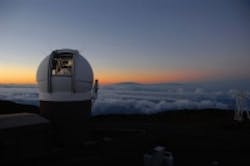Images capturedby the Panoramic Survey Telescopeand Rapid Response System (Pan-STARRS1) compiled to form the world’s largest map of the visible universehave been released to the public.
The Pan-STARRS project at the University of Hawaii Institute for Astronomy is releasing the images via the Space Telescope Science Institute (STScI) in Baltimore, MD, USA. Pan-STARRS consists of astronomical cameras, telescopes and a computing facility that is surveying the sky for moving objects on a continual basis, including accurate astrometry and photometry of already detected objects.
Pan-STARRS1 (PS1), one of the two telescopes located on site in Haleakala, Hawaii, captured half a million exposures, each about 45 seconds in length, over a period of four years. The shape of the image comes from making a map of the celestial sphere, like a map of Earth, but leaving out the southern quarter. If printed at full resolution, the image would be 1.5 miles long, and one would have to get close and squint to see details, according to the University of Hawaii Institute for Astronomy.
PS1 has a 3° field of view and is equipped with a 1.4 Gigapixel mosaic focal plane CCD camera. The focal plane has 60 separately mounted, close-packed CCDs arranged in an 8 x 8 array. Each CCD device, called an Orthogonal Transfer Array, has 4800 x 4800 pixels, separated in 64 cells, each of 600 x 600 pixels. This Gigapixel camera (Or "GPC") saw first light on August 22, 2007, imaging the Andromeda Galaxy. Each image captured by the camera requires about 2 GBytes of storage, and exposure times will be 30 to 60 seconds, with an additional minute or so for computer processing.
"The Pan-STARRS1 Surveys allow anyone to access millions of images and use the database and catalogs containing precision measurements of billions of stars and galaxies," said Dr. Ken Chambers, Director of the Pan-STARRS Observatories. "Pan-STARRS has made discoveries from Near Earth Objects and Kuiper Belt Objects in the Solar System to lonely planets between the stars; it has mapped the dust in three dimensions in our galaxy and found new streams of stars; and it has found new kinds of exploding stars and distant quasars in the early universe."
He added, "With this release we anticipate that scientists - as well as students and even casual users - around the world will make many new discoveries about the universe from the wealth of data collected by Pan-STARRS.”
The four years’ worth of images captured comprise 3 billion separate sources, including stars, galaxies, and various other objects. In total, the collection contains 2 petabytes of data, which is equivalent to one billion selfies., or one hundred times the total content of Wikipedia, according to the university.
This research was done as part of the PS1 Science Consortium, a collaboration of 10 research institutions in four countries with support from NASA and the National Science Foundation (NSF). Consortium observations for the sky survey, mapping everything visible from Hawaii, were completed in April 2014, with data now being released publicly. The roll-out is being done in two stages, as this release, “Static Sky,” shows an average value for position, brightness, and colors for individual epochs. The second rollout, which is scheduled for 2017, will provide a catalog that gives information and images for each individual epoch.
View the press release.
Share your vision-related news by contacting James Carroll, Senior Web Editor, Vision Systems Design
To receive news like this in your inbox, click here.
Join our LinkedIn group | Like us on Facebook | Follow us on Twitter
Learn more: search the Vision Systems Design Buyer's Guide for companies, new products, press releases, and videos
About the Author

James Carroll
Former VSD Editor James Carroll joined the team 2013. Carroll covered machine vision and imaging from numerous angles, including application stories, industry news, market updates, and new products. In addition to writing and editing articles, Carroll managed the Innovators Awards program and webcasts.
